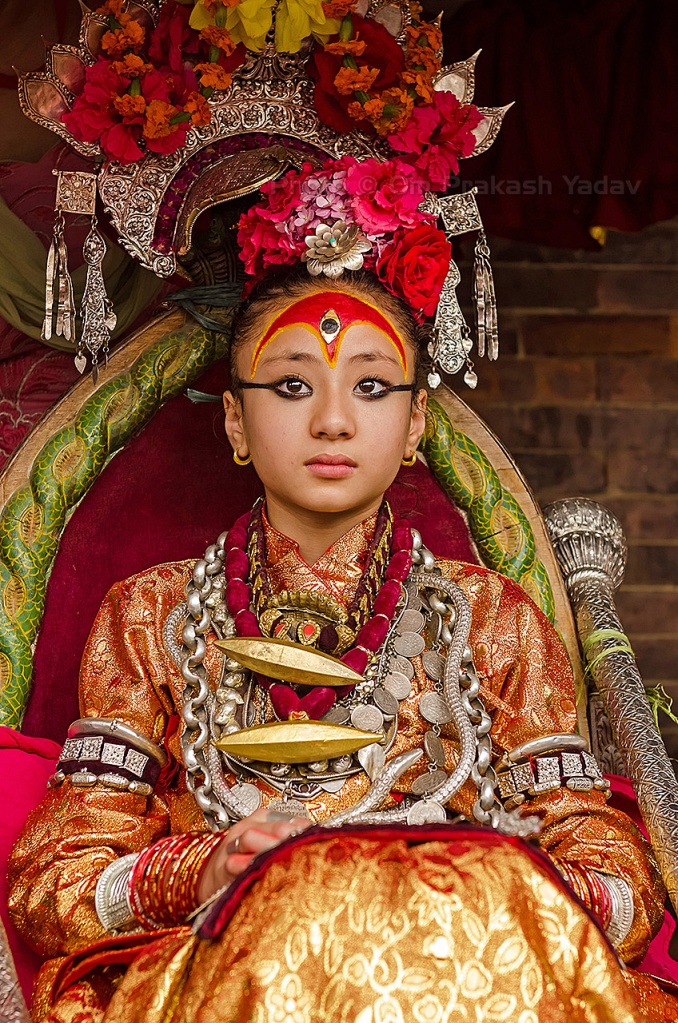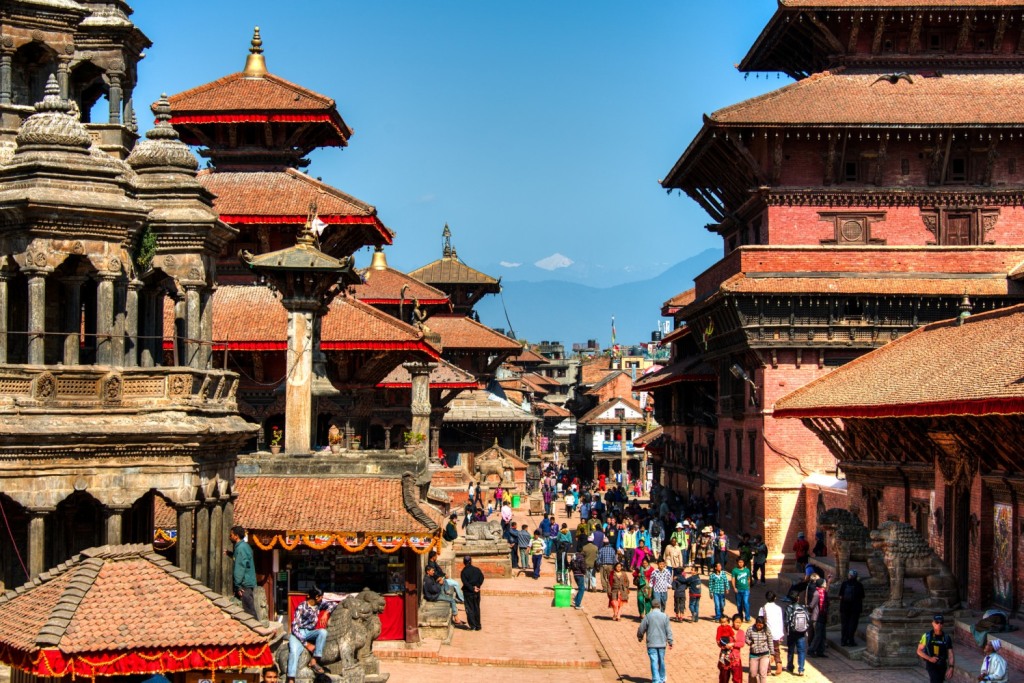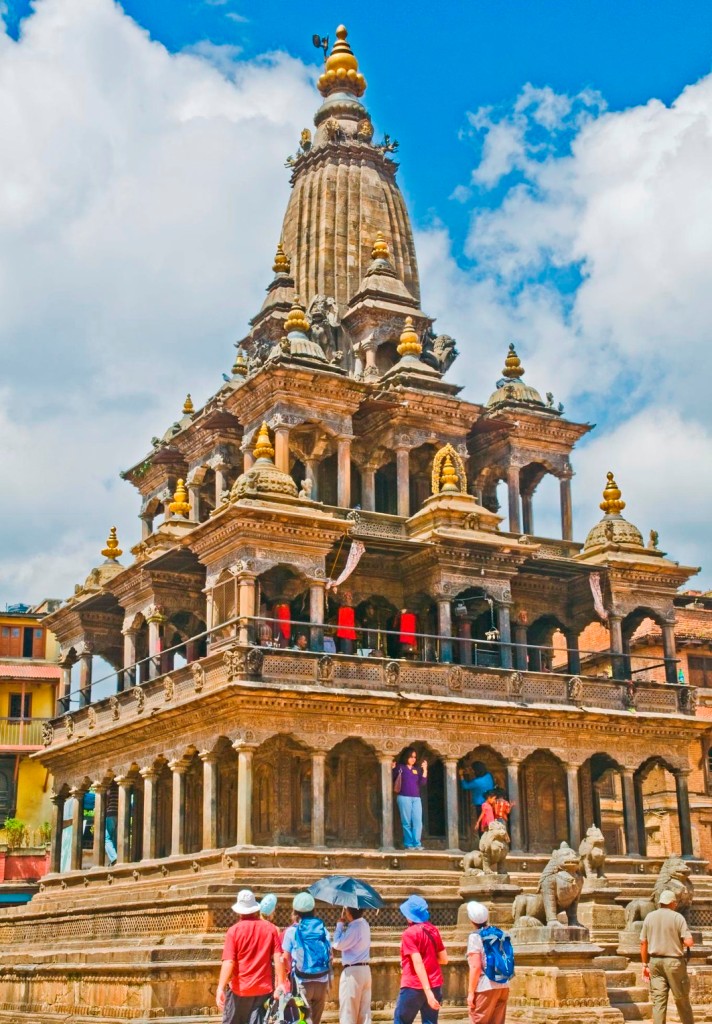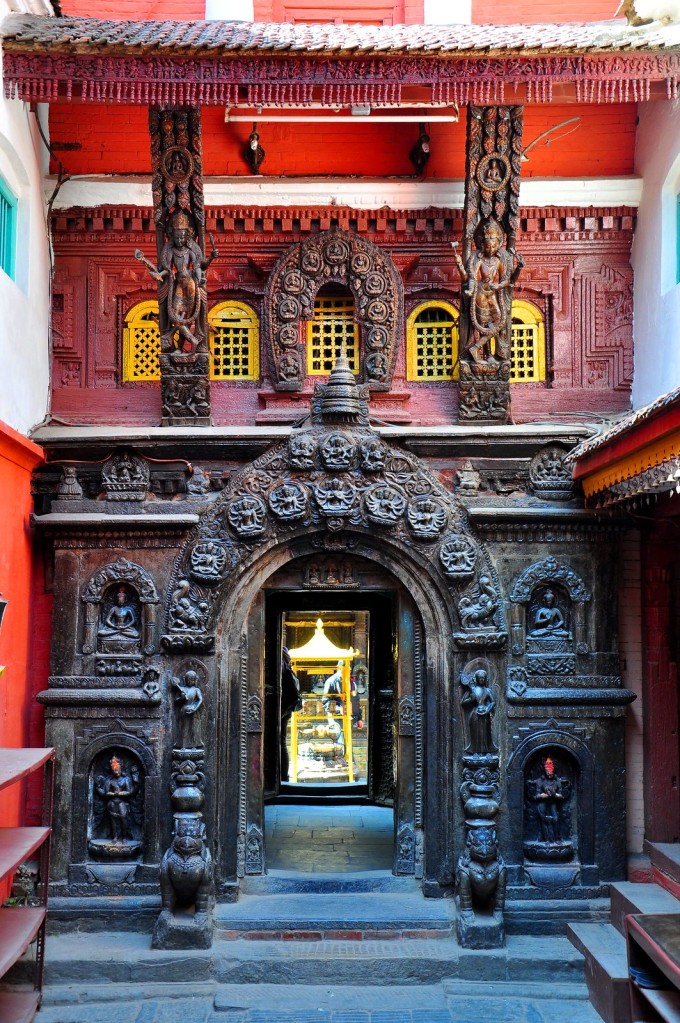Patan is 5 km away from the capital city, Kathmandu, and is reached by crossing the Bagmati River. Despite its proximity to Kathmandu, it still retains its old world charm and traditional professions such as woodcarving and especially metal crafts. As you walk through the city you still hear the tapping of tiny hammers as a craftsman works on a statuette or ornament. Patan is full of temples and monasteries which look similar in their pagoda style architecture and wood-carved windows. The district is known as Lalitpur which covers a vast area that includes the hills nearby.

Patan is a city of 55 major temples, 136 Buddhist monasteries and its artisans are known for their fine metal works. The city celebrates countless festivals both Hindu and Buddhist, many of which like the Rato Machhendranath Jatra and the display of Dipanker Buddhas are spectacular. Patan takes pride in producing great thangka and pauba painters whose works are exported to many countries. Such paintings can be seen in the little alleys of the city. Art still flourishes in this city of Newar craftsmen who have traditionally been supplying metal crafts to Buddhist monasteries around the country. The population is predominantly Newar whose castes generally determine whether they are Hindu or Buddhist.
Patan Durbar Square (durbar means palace), a UNESCO World Heritage Site is the major attraction with the old royal palace and a host of artistically designed temples all within the square. The Patan Museum within the palace has a fine collection of metal craft, wood carvings and a precious Malla era throne. In the Durbar Square is the beautiful Krishna temple built entirely of stone which is the most important Krishna shrine of the valley. Just beyond the square are many restaurants and cafes, some with rooftop views. A remarkable terracotta temple worth a visit is the Mahaboudha, a shikara style temple with a thousand images of the Buddha. Visitors enjoy the peaceful ambience of Patan and the predominance of art.
List of Places to Visit in Patan
- Patan Durbar Square
- Mahaboudha Temple
- Hiranya Verna Mahavihar
- Rudra Varna Mahavihar
- The Ashokan Stupas
- Machhendranath Temple
- Tibetan Refugee Camp
- Patan Industrial Estate
(1.) Patan Durbar Square

Patan Durbar Square is located in the center of Patan city (Lalitpur) which is about 30-40 minute drive from Kathmandu city. It is one of three main ancient royal durbar squares in the Kathmandu Valley. Though Patan Durbar Square is the smallest of all durbar squares it is often referred to as the most beautiful of all. Patan Durbar Square is also right in the middle of the overall heritage zone of Patan city making it an excellent area to base yourself from during a visit.
Places around Patan Dunbar Square
Chyasin Dewal: The very first temple you will come across is Chyasin Dewal, one of two Krishna temples in the square. The attractive octagonal solid granite temple was built in 1637-47 by Siddhi Narasimha and is worthy of a walk around as it is one of the square’s best examples of solid stone temples. Do note the two stone lion guardians at the bottom of the platform steps leading to the first floor. Inside here is the statue to Krishna. Two stone floors above have unique balconies.
Taleju Bell: Just north of the Krishna Temple is a huge cast-iron Taleju Bell. Mounted between two stone pillars it was erected in 1736-37 and rumored to terrify the king’s enemies when it was rung. More likely it was used to signal incoming invaders and later city announcements.
Hari Shankar Temple: Built in 1706 it was dedicated to Shankar Narayan deity who is half Shiva and half Vishnu. In front were two heavy stone elephant guardians who still stand today. Full description and photographs of what they used to look like and will do again are found in my guidebooks.
Jagan Narayan Temple: The second major temple to collapse in the 2015 earthquake was once the oldest in the square and was built in 1566. It used to be used for political speeches. Again, full descriptions are in my guidebooks at the bottom of this page.
Char Narayan, also called Jagannarayan, is perhaps the oldest temple in Patan’s Darbar Square. Unlike other temples in the square, it is constructed primarily of brick. Some scholars believe it was built in 1565, while others suggest the early 17th century as a more reasonable date. In any case, it honors Narayan, one of Vishnu’s manefestations.
Krishna Mandir: The Krishna temple on the west side of Patan’s Darbar square was built in 1637. Legend says that it was built because of a dream. One night, King Siddhi Narasigh Malla dreamt that the gods Krishna and Radha were standing in front of the palace. The King ordered a temple built on the same spot. During a war with a neighboring kingdom a decade later, the King emerged victorious after calling on Krishna to vanquish his enemies. In gratitude, the King built a replica of the temple inside the Sundari Chauk courtyard.

The Krishna temple is built in the shikhara style, imported from India. Beneath its 21 golden pinnacles are three floors. The first floor enshrines Krishna, the second Shiva, and the third Lokeshwor. Scenes from the Ramayana narrated in Newari script decorate the interior of the temple.
Vishwanath temple: Vishwanath is a manifestation of Shiva. The temple was built between 1676- 78 during a time when King Siddhi Narsingh witnessed the moguls destroy the Vishwanath Temple in Banaras. Today you can view two stone riders on elephants guarding it.
Bhimsen Mandir Temple: Our last temple on the left hand-side moving up Durbar Square was built in 1680 at a time when all three kingdoms in Nepal were at peace. It’s dedicated to the Newari god of traders Bhimsen. There’s a fire pit opposite it for rituals and a tall pillar. Crossing over to the other side of the street you’ll see a large hiti or sunken water source known as Manga Hiti. Though damaged it still functions today though without its gates.
Keshav Narayan Chowk / Patan Museum: Patan Museum is housed in a courtyard within the Northernmost building complex of the Durbar area. The most picturesque setting of the palace that has been created in so small a place by piety and pride is known now to the people as Keshav Narayan Chowk after a temple standing at the center of the courtyard dedicated to Keshavnarayan- a form of Lord Vishnu.This part is recorded in the history as Chaukot Durbar or four-cornered-fort-palace.
This is the first public museum in Nepal that has been created as an autonomous institution of this type managed by its own Board of Directors. The museum has been acclaimed, by the visitors, as one of the finest museums in South Asia. The popularity is growing day after day and is economically self sustained now.
The collaborative effort of Austrian Government with Nepalese counterpart did not only restore the historical palace to its original grandeuer but also created a Model Cultural Institution in Nepal.
Mul Chowk: Damaged during the earthquake renovation is nearly complete. Today it’s often used as a restoration area by artisans. The courtyard was built in 1666 and is known as the heart of Durbar Square. It is now quite plain aside from the gilded figures straight ahead Ganga and Jamuna, goddesses of the river system that runs from the Himalaya and the copper shrine in the middle. Two decades ago the courtyard was richly decorated in wood work until several thefts left it bare. Continue through to Sundari Chowk.
Sundari Chowk: In the Patan Durbar Square, there is the beautiful courtyard of Sundari Chowk with an entrance guarded by the three impressive statues of Hindu deities Hanuman, Ganesh and Narsingha. It is one of the three main courtyards in Patan Durbar Square and is located south of its more famous neighbour, Mul Chowk. Relatively smaller than Mul Chowk, this area is arranged around a carved sunken water tank known as Tusha Hiti and has the Bhandarkhal water tank which was once the main supply tank royal palace.
Bhandarkhal Tank Don’t leave Sundari Chowk without taking a quick look to the rear where the fully restored Bhandarkhal tank or pond now lies. Built in 1667 it was once Durbar Squares main supply of water. This courtyard is a living museum. It preserves its architectural elements in its natural environment, rather than simply displaying them in glass cases. One example of Kathmandu’s intricate water architecture is the Tusha Hiti waterspout, which features an image of Vishnu with Lakshmi on his lap, carried by their mount, Garuda. Lined around the walls of the step-well are three rows of 72 elaborately carved stone sculptures.
(2.) Mahaboudha Temple
To the east of the Durbar Square you will discover the Temple of Mahaboudha, built in the 14th century. A serene Buddhist monument made of clay bricks and styled in the beautiful art form of terra-cotta, Mahaboudha Temple is so different to that of the pagoda roofs and temples surrounding it.
Engraved into the walls of Mahaboudha Temple are up to nine thousands carvings of images of Buddha, giving Mahaboudha its name and showing off the designs and creative skills held by the craftsmen of Patan. Although grand in height, this impressive temple is tightly hidden by surrounding buildings making it inconspicuous. The temple is designed in commemoration to the original temple in India called Bodhigaya after Lord Buddha, his life and contributions.
The area in which Mahaboudha Temple is located has been through many trials as over the centuries. Earthquakes have repeatedly ripped through the historical valley of Kathmandu devastating temples and palaces during the significant period of 1934, to a point of no recognition. Thankfully as time has passed so the reconstruction of the history of times past has been revived with buildings raised to their former glory. In most cases structures are duplicated to their original standing. The Mahaboudha Temple in Patan, which was built by the priest known as Abhaya Raj, still contains some of the original bricks used in its construction. Residents of Patan greatly appreciate the many projects that have been taken on by foreign funded programs, such as the German-based Bhaktapur Development Project, which was responsible for the restoration of over a 100 buildings in the Nepalese city. Another project has been successfully seen in the small town of Panauti in the southeastern corner of the valley which was supported by a French-Nepali agreement.
(3.) Hiranya Verna Mahavihar ( Golden Temple)
Golden Temple Located in north Patan the Golden temple is officially known as Hiranya Varna Mahavihar or locally as Kwa Bahal. The translation means “Gold-colored Great Monastery”. It is perhaps the second most popular attraction in Patan after Patan Durbar Square. The temple was built in 1409 and is in fact a Newari Buddhist monastery. The name “golden temple” came about through tourism and a shortening of it’s translation more than it actually being made of pure gold. Most of the temple is actually polished gilt copper which gives it a fantastic golden shine. Inside the main courtyard there are probably enough artifacts to keep most historians happy for a full day. Please note that that leather items are not permitted inside temple.

At the main entrance there was once a duel fought between a Brahman and Vajracharya Buddhist priest. The Vajracharya priest won when his wife threw here sari over the Brahmans head which led to the priest decapitating him. It’s said the severed head is still used in ceremonies today!
At the entrance way are two large brass guardian elephants and riders. Directly in front is a lavish shrine with a silver and golden chaitya. While you can’t photograph inside the shrine you may photo around the interior of the courtyard. Golden Elephants at the Golden Temple in Patan Going clockwise around the central shrine you’ll see newly added (1918) brass monkeys holding out jack fruits as offerings. Behind them are large bronze Bodhisattvas. Three are Padmapani Lokeshwar and the fourth is Manjushree. The main shrine (directly behind the smaller one) contains a statue of Sakyamuni and a Buddha image which again should not be photographed without permission. The temple is dedicated to Guatama Buddha.
(4.) Rudravarna Mahavihar
Rudravarna Mahavihar is one of the most beautiful of such pagoda style temples. It is located in Okubahal, Lalitpur, is the second most important vihar in Kathmandu Valley. Just next only to Hiranayavarna Mahavihar, also known as the Golden Temple, in Kwabahal of Lalitpur. The two mahavihars share many similarities, both being three-roofed pagoda-style temples housing huge statues of Shakyamuni Buddha. However, there are differences as well. There are more devotional activities in Hiranayavarna Mahavihar than in Rudravarna Mahavihar, and the former certainly has a livelier environment, especuially in the early hours of the morning, when many devotees come to pray and worship. On the other hand, Rudravarna Mahavihar is said to be the best-maintained vihar in the valley, and is spic-and-span at all hours. Anyway, however one looks at it, it is a fantastic example of Newari Buddhist culture, architecture, and art.
At the four corners of the vihar are four truly exotic statues of deities made by no less a sculptor than the late Mr. Siddhi Ratna Bajracharya, an icon in the field of metal sculpting. The vihar is full of many other beautiful works of art in metal. This is no surprise, since Okubahal in Lalitpur is the center of metal sculpting in Nepal. So much so, that if you ask around the place, you’ll find that almost every house is involved in metal sculpting! Behind the mahavihar is a spacious courtyard called Ta:Go Chiva, meaning ‘Big Stupa’, which refers to a large white stupa in the center. Rows of houses surround the courtyard, and the first one near the entrance from Mahaboudha Chowk belongs to master sculptor Mr. Sanat Kumar Shakya, who is famous for his exotic Sahasra-bhuja Sahasra-netra ((Thousand-armed, Thousand-eyed Avalokitesvara) figures. He is also one of the committee members responsible for the upkeep of Rudravarna Mahavihar.
The daily worship in the mornings and evenings are conducted by a priest and some elders of the local Shakya clan. Once in his lifetime, a male member of this clan has to be a priest of the vihar for at least two weeks. This is, seemingly, another difference with Hiranyavarna Mahavihar, where the
priest has to be from the Bajracharya clan. Shakya and Bajracharya are branches of the Newar community that conduct religious rituals. Anyway, the priest of Rudravarna Mahavihar is almost always a young man who dresses in black robes during his priestly tenure. As mentioned before, Rudravarna Mahavihar stands in a historic locality, and this is all the more so due to the presence of the renowned Mahaboudha Temple with its one thousand terracota Buddha figures just a few meters away.
(5.) The Ashokan Stupas
Nepal is the center for Buddhist culture in the country. A fine example of Buddhism in the country is its temples and their stupas. This includes the four Ashoka Stupas. Named after the Emperor Ashoka of India, these stupas not just show Buddhist architecture, but they even reflect different wheels of Buddhism- the wheel of righteousness or dharma. These stupas were traditionally built as markings on the four corners of Patan.
These stupas are mounds crowned monuments that were erected in 250 century B.C. Three of the mounds that are constructed have been covered in grass. The fourth one has a white mound and a colorful monument. It is believed that such a construction stems out from the fact that Buddhist stupas are supposed to be different from each other. So, certain highlights and changes are made for each of the design to preserve their uniqueness. That’s why each of the stupas should be explored.
(6.)Machhendranath Temple
The temple of Red Machchhendranath, the God of Rain is of great importance in Patan. The temple lies in the middle of a wide, spacious quadrangle just at the outer rim of the market place. A clay image of Red Machchhendranath or Avalokiteshwar is kept here for six months each year, after which it is placed on a chariot and taken round the city of Patan in a boisterous colorful procession as part of a festival that begins in April-May and lasts for several months.
(7.)Tibetan Refugee Camp
A large number of Tibetans fled their homeland in Tibet and settled in Nepal during the early 1960s. To shelter these homeless people the government of Nepal set up the Tibetan Refugee Camp on the outskirts of Patan. The Tibetans brought their carpet weaving skills to Nepal and soon a carpet industry was thriving in the valley. The camp has become a tourist attraction with its souvenir shops that sell carpets and handicrafts such as prayer wheels made of wood, ivory, silver or bronze along with an assortment of belt buckles, wooden bowls and jewelry. A stupa and a number of shrines have also been built within the camp.
(8.)Patan Industrial Estate
Patan Industrial Estate is located at Lalitpur, around 500m south of Lagankhel bus stand near Satdobato. This Industrial Estate is prominent for Nepali handicrafts such as wood carvings, metal crafts, carpets and thangka paintings.
For the expediency of the tourists there is a shopping arcade where all handicraft products of the estate are displayed. Patan Industrial Estate was created in 1963 under the Company Act as with sponsorship from India. Patan Industrial Estate is part of a superior organization called Industrial Districts Management Limited that was previously known as ID, established in 1960 with the support from the United States. Patan Industrial Estate also function to encourage industries in the estate and take on the in general management and custody of the whole estate itself and to recognize problems of industrial units set up on the estate and provide management consultants and extension services for the improvement of their operation and productivity. It used to offer product valuation but no longer does, as the practice was not possible. It also circulates information on possible projects and conveniences accessible on the estate. Political instability however tend to effect the industrial growth.

